Contents
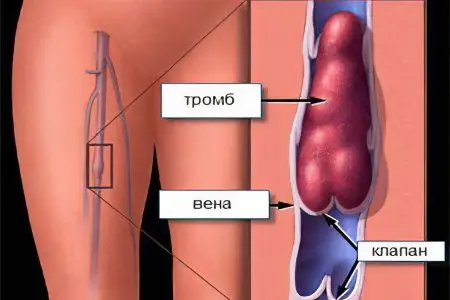
Thrombosis is a disease characterized by the formation of blood clots in the vessels. They block the lumen of a vein or artery and disrupt the normal supply of blood to a specific organ or part of the body. The lower extremities become a frequent site of localization of blood clots. If a person with a thrombus in the leg does not seek medical help in time, the disease can end in death or disability.
The main complication of the pathology is the detachment of a blood clot, which, together with the blood flow, begins to travel through the blood vessels. If it reaches the arteries of the heart or lungs, then they become blocked. This can result in an increase in symptoms of pulmonary and heart failure, or myocardial infarction. When a blood clot enters the vessels of the brain, the patient has a stroke. Therefore, it is so important to know the symptoms of a blood clot in the leg and seek medical help in a timely manner.
Causes of a blood clot in the leg
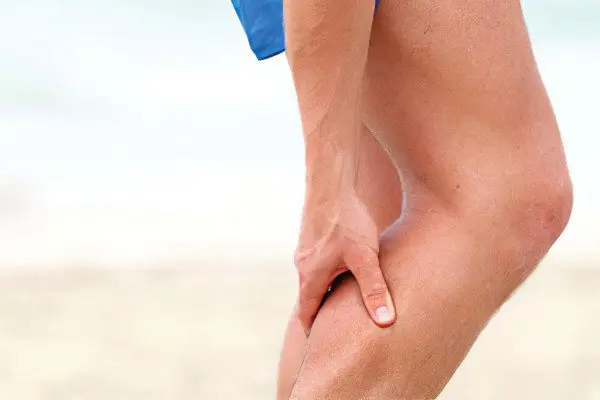
Thrombi begin to form against the background of violations of blood coagulation processes. In those places where the vessels are damaged, clots form from blood cells and fibrin fibers. Also a favorite place for the localization of blood clots are atherosclerotic plaques.
The clot becomes an obstacle in the way of blood flow, so more and more blood cells join it. Another negative factor affecting the accelerated growth of a thrombus is inflammation of the vascular wall.
So, in order for a blood clot and fibrin filaments to form in the leg, three conditions are necessary:
Violation of blood coagulation processes.
Violation of the integrity of the vascular wall.
Slow down blood flow.
Risk Factors
Triggers that contribute to the development of the disease are:
Received trauma of the lower extremities.
Surgical intervention on the veins of the lower extremities, or on soft tissues.
Transferred infectious diseases.
Prolonged time sitting or lying down.
Sedentary lifestyle, low physical activity.
The period of bearing a child and the early postpartum period. In this case, thrombosis will be due to hormonal surges in the woman’s body.
DIC syndrome.
Taking hormonal contraceptives.
The presence in the body of a cancerous tumor of a malignant nature.
old age.
Diseases of the cardiovascular system.
Weighed down heredity.
Types of blood clots in the leg

The most dangerous type of thrombus is considered to be a floating clot. Such a thrombus is located on a thin stalk, which can come off at any time.
Parietal thrombi are also distinguished, which most often form around atherosclerotic plaques. They pose less of a threat in terms of separation, however, the risk of embolism remains.
Occlusive thrombi are formations that grow to an impressive size, thereby blocking the flow of blood through the vessels. Such blood clots often form in the lower extremities.
Depending on the location, venous thrombi are isolated, which lead to the development of thrombophlebitis (damage to the saphenous veins) and phlebothrombosis (damage to the deep veins of the lower extremities). There are also arterial clots that localize in the arteries of the legs and cause a disease called arterial thrombosis.
Symptoms of a blood clot in the leg
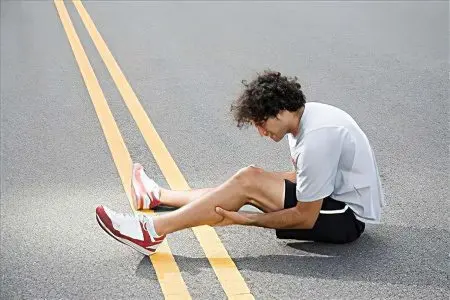
Initially, the disease can develop hidden, making itself felt only after the first complications.
However, about half of patients experience the following symptoms:
Feeling of heaviness in the lower limbs.
Swelling of the legs, not associated with heavy drinking or overwork.
Blueness of the skin of the legs.
Bursting pains in the legs of varying intensity.
Local and general increase in body temperature.
Inflammation of regional lymph nodes.
Pain when touching the lower limbs.
Swelling of superficial veins, strengthening of the venous subcutaneous pattern on the legs, in the lower abdomen, in the thighs.
These are common symptoms that characterize the presence of a blood clot in the leg.
Arterial thrombosis is accompanied by the following symptoms:
Numbness of the extremities, a decrease in body temperature below the area where the blood clot formed.
Pain that tends to get worse.
Loss of sensation in a limb.
Leg immobility.
As for thrombophlebitis, in which blood clots are localized in superficial veins, it is accompanied by the following symptoms:
Veins become dense, expand.
When touching the veins, a person experiences pain.
The skin over the veins becomes red.
Symptoms of phlebothrombosis, in which a blood clot forms in the deep veins of the legs:
Puffiness
Blueing of the skin.
Heaviness in the legs.
Pain in the lower limbs.
The formation of subcutaneous blisters filled with fluid.
General intoxication of the body.
If a patient develops thrombosis in the arteries of the lower extremities, then in 10% of cases it will end with its amputation. Thrombophlebitis is almost always a complication of varicose veins. If thrombophlebitis is not treated, the disease will be accompanied by frequent relapses and will be complicated by the transition to deep vein thrombosis of the legs.
Complications of blood clots in the leg
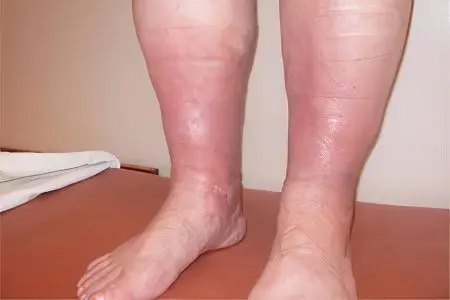
If the thrombus is located in the deep veins of the lower extremities, then the patient often develops chronic venous insufficiency. This complication is expressed in edema of the legs, in malnutrition of tissues. As the pathological condition progresses, the patient may develop gangrene, eczema, and a trophic ulcer.
The most serious complication of a blood clot in the leg is pulmonary embolism. In this case, small pieces of a blood clot migrate with the blood flow to the pulmonary artery. When they fall into its narrow part, a blockage of the vessel occurs. Violation of blood flow provokes acute respiratory and heart failure, so it is not always possible to save the victim.
Other complications of a blood clot in the leg include pulmonary infarction, cerebral stroke, myocardial infarction, amputation of a limb against the background of developing gangrene, suppuration of a blood clot and abscess.
Diagnosis of a blood clot in the leg
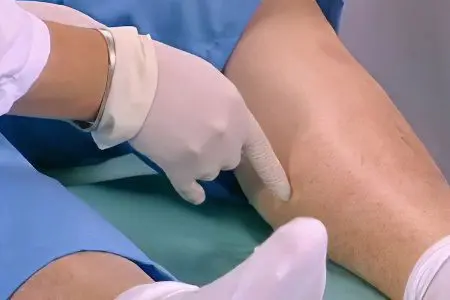
If a person has a suspicion that a blood clot has formed in his lower limb, he needs to seek help from a doctor. First you should visit a therapist who will give a referral to a phlebologist.
Already during the initial examination, the doctor will be able to make a preliminary diagnosis. To detect a blood clot in the leg, the following tests can be performed: marching test, Homans test, Lowenberg test, tourniquet tests, etc.
Modern phlebology has a sufficient number of instrumental techniques that allow you to detect pathology:
Duplex angioscanning of blood vessels.
Dopplerography.
Rheovasography of the lower extremities.
Radionuclide scanning.
A clinical blood test does not allow making a diagnosis, but with thrombosis, the ESR, leukocytes, and platelets will be overestimated. Be sure the patient must donate blood for a coagulogram and a D-dimmer test. A comprehensive examination will allow you to collect maximum information about the patient’s state of health and prescribe him adequate treatment.
Treatment of a blood clot in the leg
If a person has a blood clot in his leg, he must be hospitalized. Provided that medical assistance is provided in a timely manner, a blood clot can be completely eliminated without surgical intervention. However, no specialist can guarantee the recurrence of the disease.
If a patient is diagnosed with arterial thrombosis, then the following treatment is shown to him:
Performing a thrombectomy, in which the clot is removed surgically. The operation on the vessels can be performed in an open and closed way. Most often it is carried out on an emergency basis. Anesthesia is performed locally. General anesthesia is indicated for reconstructive interventions (bypass surgery, prosthetics, thrombinthymectomy).
Elimination of the root cause of the disease, which led to the formation of a blood clot.
Appointment of antispasmodics.
Carrying out antithrombotic therapy with the use of several drugs.
If the patient is diagnosed with deep vein thrombosis of the legs, then he is shown strict bed rest. The affected leg is fixed in an elevated position. If deep vein thrombosis is diagnosed in the later stages, or is complicated by severe circulatory disorders, then the patient is prepared for thrombectomy.
[Video] Cardiovascular surgeon, phlebologist Abasov M. M. – How to get rid of a blood clot in 2 weeks:









